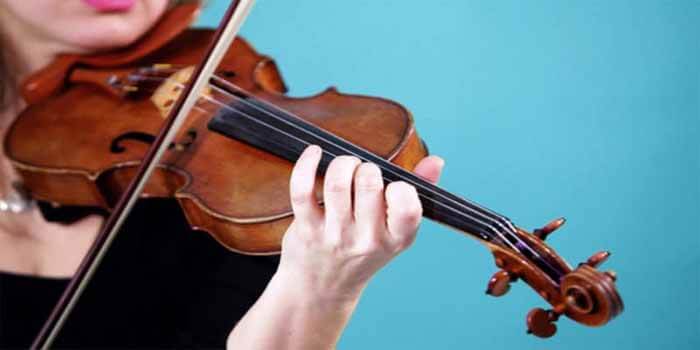Versatility, finesse and clarity – aren’t these the 3 specific play ability attributes the groomer of your beginner violin lessons continually advise you to evolve at?
Well, it principally depends upon with how much –
- Spontaneity
- Strength
- Suppleness
- Sharpness
your fingers are maneuvering the instrument and bow. Acknowledge that –
- Those performances of famed violinists that strike and stun your heart is pre-eminently structured upon the overwhelming deftness and intensity their ‘digits’ possess.
And, as a principal factor, plays behind that their committed and scheduled practice of some utmost effective finger drills.
Regularly endeavoring for fingering exercises has also been the ‘de jure’ suggestion of your violin teacher, right?
But is it that the defined time-limit of practice turns it difficult to focus over both lessons and finger training in the apt style?
What if you can get learned about some definite finger work-outs that do not always necessitate either the violin or stick and can be practiced at any time and place? Optimally convenient but too strange to recognize as a real-time fact?
Rule out the apprehension by paying attention to the so-smartened calisthenics showcased right here to this end:
Fingering Hacks Developing Your Violin Play
(Alert: Make sure to practice each of these drills over digits of both hands since ‘all the 10’ play equally vital roles to enrich what you strum. The right hand indexes administer the bow’s sway-through and hold – with the left hand ones controlling every intonation created upon the gear.)
The Warm-Ups
Indispensable for multiplying the grit of involved muscles and lowering the fingers’ fatigue quotient, the most preferred-by-experts exercises come up to be –
Lifts
- Lay the palm (any hand you desire to initiate with) in a down-sided fashion upon a leveled surface
- In a much soft manner, raise each finger up to the extent you can and stay for 5 seconds
- Follow the order of thumb<middle finger<index digit<pinky<ring finger
- As a beginner doing 5 such sets over each hand turns out to be good-enough – however try to double the mark gradually
Spider Move
Championed by most eminent violin lessons Singapore, this distinctive callisthenic is meant to improve not only your fingers’ holistic potency – but also the fortitude of the wrists and forearms. It urges you to:
- Stand, by a literally ‘adhered’ style, against a flat wall
- Position palm (one hand/time) over it
- Move your hand up the wall, in a crawling way (be as slow as possible) by deploying every finger
- To the limit you can reach for the first time, linger till 8-10 seconds
- By imitating a spider’s sneaking movements, the wrist develops own gravity, which eventually infuses quite-much intensity to your digits
Stretch Through Touch
- Let your palm stand in an absolute upright position over a flat table surface
- Attempt touching the pinky’s end with the thumb and count for 4
- ‘Bring’ the thumb back to its actual ‘place’
- Now make it touch the index finger’s top for a 5 seconds stretch
- Daily training of this drill aids you to safe-guard fingers from accidental injuries during performance
Being Flexor
The easiest of the ‘lot’ yet, as vowed by the revered faculty of Stradivari Strings, most productive for the fingers to accomplish tenacity and power. Simply:
- Position the forearm and hand horizontally over the dinner table
- Reach out for your other hand
- Through it and in a mild manner tug each digit of the flattened hand towards the very wrist up to the point when you feel resistance but not pain
- Repeat the complete drill by reversing the hands
Loosen Your Right Thumb
A prime advice put forward by all famed violin lessons for beginners. What happens in the practical scenario is that in their effort to maintain a firm ‘hold’ over the bow, amateurs end-up with one way-too rigid thumb pose facing the bow.
Termed as “banana thumb”, this eventually lets you produce nothing but raw buzzes over the violin and makes the stick most annoyingly jump tie and again.
Prevent the Agony by –
- Practicing gentle ‘close & open’ movements over your thumb (thus increasing flexibility) before taking on plucking
- Having it ‘embrace’ the bow in a little curvy way
- Checking for any shrieks or bow rebound issues while strumming
- If noted, loosening up the thumb even more
A ductile thumb, in effect, enriches the benchmark of acoustics you create.
Finger Goes to Thumb
A particular drill for your left hand, continual practice of this ‘hack’ permits you to be more ‘natural’ and nimble with regards to pitch positions and alterations–
- Open stretch the left palm
- Relax the thumb
- Then, touch its end with the tip of every left digit
- Pursue one-at-a-time rule and count till 5 for each
- When one finger goes, the others must stay still
- And, correspondingly, try to prevent the spontaneous ring finger movement while goes the pinky
- Gradually enhance the time count and keep track upon the duration your fingers are being able ‘to stay’ without feeling discomfort
The more your indexes can resist higher becomes the quotient of deftness thus achieved.
Pressure Balance
By the perspective of bestest violin lessons Singapore, one ‘must’ callisthenic for staying safe from frequent finger cramping.
In a gentle style let tip of each digit ‘unite’ with the thumb top. Now, press hard this ‘joint’ till the fingertip naturally ‘slips down’. Try to linger for at the least 10 seconds during the initial days.
Also, be careful of not hurting the pinky, since the finger is inherently weak in comparison to your thumb.
With dedicated training, when you can let even the 4th digit (pinky) dwell comfortably for long, know that the muscle memory is developing.
The ‘C’ Shape
The fittest work-out to make the fingers flexible and agile as well. Form a perfect ‘C’ with digits of one hand. Now, in an impulsive motion, draw the fingers close together and place the thumb in front.
Have the fist thus created, ‘stay hard’ for 10 seconds. Break it and endeavor for the other palm.
Though a bit tough, do not go less than 7 sets even at the beginning and heighten the benchmark as your digits become suppler.
Ever Important Rules
- As you strum, always maintain a lifted left knuckles pose, so that the higher notations can be accessed easily and the pitch does not sound ‘broken’.
- With every practice, venture to expertise over the ‘finger guiding finger’ trick. For pro violinists, their one digit leads just the next one to its accurate place for playing a following chord. This consequently boosts your playing pace and helps to remain ‘in tune’ forever.
- To master the afore-mentioned tactic imperative it is to adeptly memorize the finger names. So, as another ground-norm, endeavor to identify each digit with aid of your teacher or apps recommended by the one. Knowing them moreover allows you to perfectly ‘sync in’ with the tab sheet and grow, overall, as a player.
(Spoiler – For the right hand it starts with violin thumb-1st finger/index – 2nd finger/middle – 3rd finger/ring ending at the 4th/pinky. Coming to the left part, digit names vary with respect to their different placements over bow.)
Fine and melodious finger play to you!




